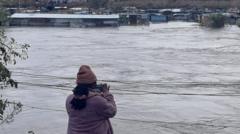As Storm Eowyn sweeps through Ireland and beyond, over 715,000 customers have lost power while severe weather conditions continue to unfold.
Storm Eowyn Causes Widespread Power Outages Across Ireland

Storm Eowyn Causes Widespread Power Outages Across Ireland
Record winds leave hundreds of thousands in the dark, disrupting travel and emergency services.
Hundreds of thousands of people found themselves without electricity in Ireland on Friday, as Storm Eowyn unleashed its fury across the region, bringing unprecedented wind speeds and chaotic travel conditions. The storm's impact was significant, with the Irish Meteorological Service predicting widespread gales throughout the day.
With gusts reaching a staggering 70 miles per hour in many areas, the storm's worst effects were felt in western Ireland, where Mace Head in County Galway recorded an astonishing gust of 114 miles per hour—shattering a long-standing record from 1945. As of Friday morning, the ESB Networks reported that around 715,000 of its 2.4 million customers were without power, representing nearly a third of the utility's service area.
In addition to strong winds, Eowyn is expected to bring persistent rain showers, along with the potential for hail and even snow in the elevated regions of Scotland. The UK's Meteorological Office has issued warnings regarding "very dangerous conditions," noting that the storm is likely to cause extensive disruptions across the affected areas.
Travelers were significantly hampered, with Northern Rail in England advising riders to avoid journeys on Friday and Saturday due to severe storm-related disruptions. Airports throughout Ireland and the UK saw hundreds of flights canceled or delayed; Belfast International Airport warned passengers of intermittent power outages and urged them to check their flight statuses carefully.
The storm's rapid intensification was aided by a strong jet stream—a high-altitude air current that influences weather patterns. This increased jet stream activity, which surged from the normal speeds of 190 to 220 miles per hour to an exceptional 260 miles per hour, has contributed to Eowyn's destructive capabilities.
This event marks the most significant storm to impact Ireland since 2017, when a powerful storm wreaked havoc, resulting in multiple fatalities. Weather experts continue to monitor the situation closely as communities brace for further challenges from this unprecedented meteorological event.
With gusts reaching a staggering 70 miles per hour in many areas, the storm's worst effects were felt in western Ireland, where Mace Head in County Galway recorded an astonishing gust of 114 miles per hour—shattering a long-standing record from 1945. As of Friday morning, the ESB Networks reported that around 715,000 of its 2.4 million customers were without power, representing nearly a third of the utility's service area.
In addition to strong winds, Eowyn is expected to bring persistent rain showers, along with the potential for hail and even snow in the elevated regions of Scotland. The UK's Meteorological Office has issued warnings regarding "very dangerous conditions," noting that the storm is likely to cause extensive disruptions across the affected areas.
Travelers were significantly hampered, with Northern Rail in England advising riders to avoid journeys on Friday and Saturday due to severe storm-related disruptions. Airports throughout Ireland and the UK saw hundreds of flights canceled or delayed; Belfast International Airport warned passengers of intermittent power outages and urged them to check their flight statuses carefully.
The storm's rapid intensification was aided by a strong jet stream—a high-altitude air current that influences weather patterns. This increased jet stream activity, which surged from the normal speeds of 190 to 220 miles per hour to an exceptional 260 miles per hour, has contributed to Eowyn's destructive capabilities.
This event marks the most significant storm to impact Ireland since 2017, when a powerful storm wreaked havoc, resulting in multiple fatalities. Weather experts continue to monitor the situation closely as communities brace for further challenges from this unprecedented meteorological event.






















